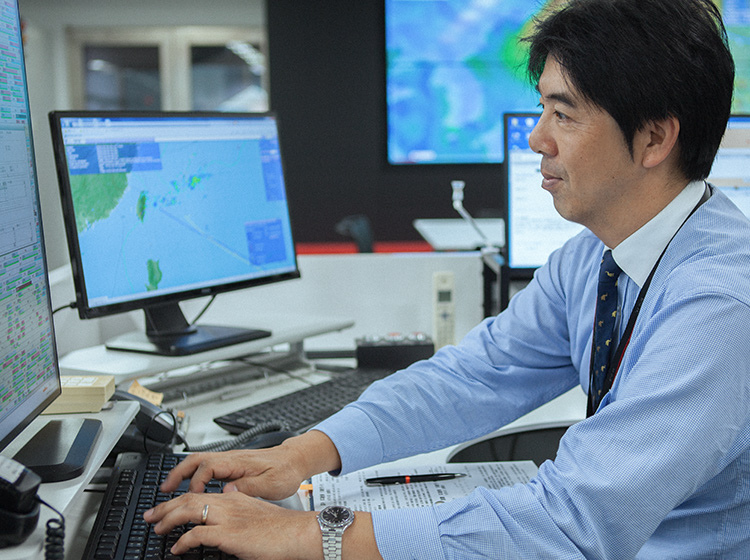
BATON 03
Operation Control
Load Control
The fortress of flight safety and the cornerstone which controls weight and balance of aircraft.

ABOUT
Operation Control Center (OCC) centrally controls operations of aircraft operating around the world. To provide safe and high quality operations, OCC supports every section engaged in operations, in case of an irregularity quickly deals with customers and internal related parties, and relays accurate flight information to customers and internal related parties.
OCC monitors and assists operations 24 hours a day to ensure safe and smooth flight operations. Load Control is in charge of controlling Weight & Balance of aircraft. It decides loading positions in cargo compartments based on the number of passengers, seating locations, the weight of checked baggage and cargo, and such to ensure that Weight and Balance is within prefixed limits.

INTERVIEW
The Operation Control Center (OCC) operates 7/24, monitoring aircraft safety and flight operations and supporting flight crew in the air and airport staff on the ground. The Mission Director (MD) is responsible for daily operations, takes command over OCC operations in general, and makes the final decision on behalf of the President. His mission carries a large responsibility, which affects risk management.
JAL flight operations are affected by weather, natural disasters such as typhoons, terrorist attacks around the world, and such. To ensure safe flight operations in these circumstances, decisions must be made based on accurate information. The OCC asks schedule controllers, dispatchers, maintenance engineers, crew schedulers, airport staff, reservation staff, etc. for their opinons, and seriously discuss the degree of impact on flight operations, possible measures, and so forth. The MD makes the final decision as quickly as possible, while taking into consideration the opinions of the abovementioned professionals in their respective fields, and not based on his own opinion, possible safety impediments, the best solution for customers, requests from airport staff who serve customers, and so on.
The OCC is the fortress of daily flight safety. We feel that improving the quality of our decisions based on experience will lead to improving the quality of JAL flights, and ultimately lead to customer satisfaction. Although we do not personally serve the customers, we will support JAL staff who serve them and do our best to have customers and staff feel that "JAL has changed" and make JAL their favorite airline.
PASS THE BATON
OPERATION CONTROL CENTER

Flight plan and
flight watch
We make the flight plan based on information on airports, weather en route, etc. on the day of departure, and decide the flight course, cruising altitude, loaded fuel, etc. with the Captain. After departure, we keep watch of flights in operation, send information from the ground to the aircraft as necessary, and support flight safety.

Schedule Control
In case an irregularity occurs such as mechanical trouble, bad weather and runway closure, we make decisions from the perspective of the "best for all" and minimizing the impact on the customers. For example, we may decide to change aircraft, or delay or cancel flights depending on the situation. When implementing control measures, we coordinate and exchange information with airports, maintenance engineers, crew schedulers, etc. and make appropriate decisions.

Load Control
Aircraft cannot fly safely unless weight and the center of gravity (C.G.) are within prefixed limits. For example, if the C.G. position is towards the rear limit, it will cause a tail strike, and if it is close to the forward limit, it will not be possible to raise the nose with the control stick. If weight is not within the limit to match the distance of the runway, the aircraft will not be able to take off or land. Given this importance, the Civil Aeronautics Law stipulates that the Captain must check the weight and C.G. before departure; otherwise, the aircraft is not allowed to depart. Load Controllers decide the loading positions and weight of cargo and baggage to be loaded in cargo compartments, located beneath the cabin floor, in order to keep weight and C.G. within limits, and notify the Captain of the final weight and C.G.
